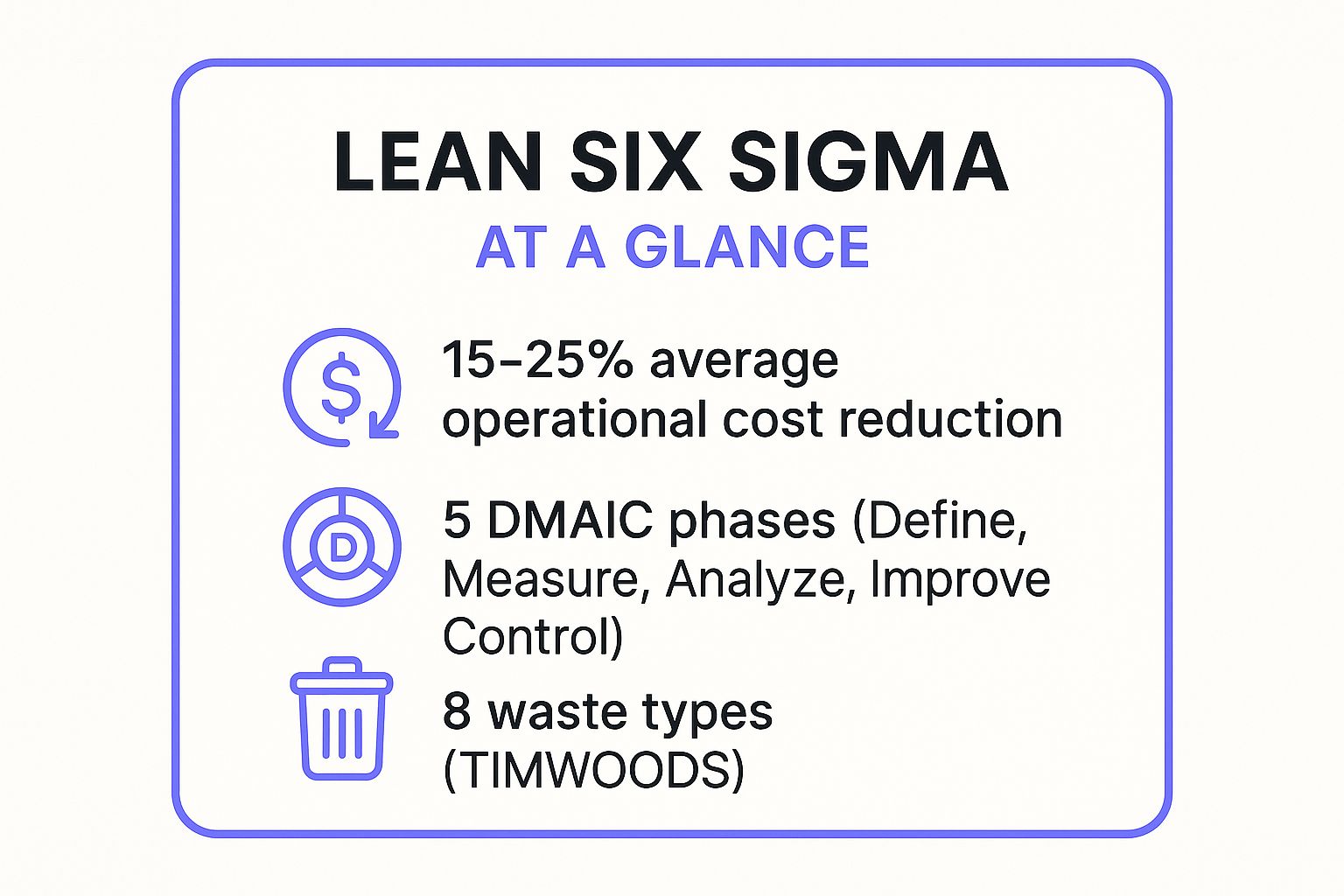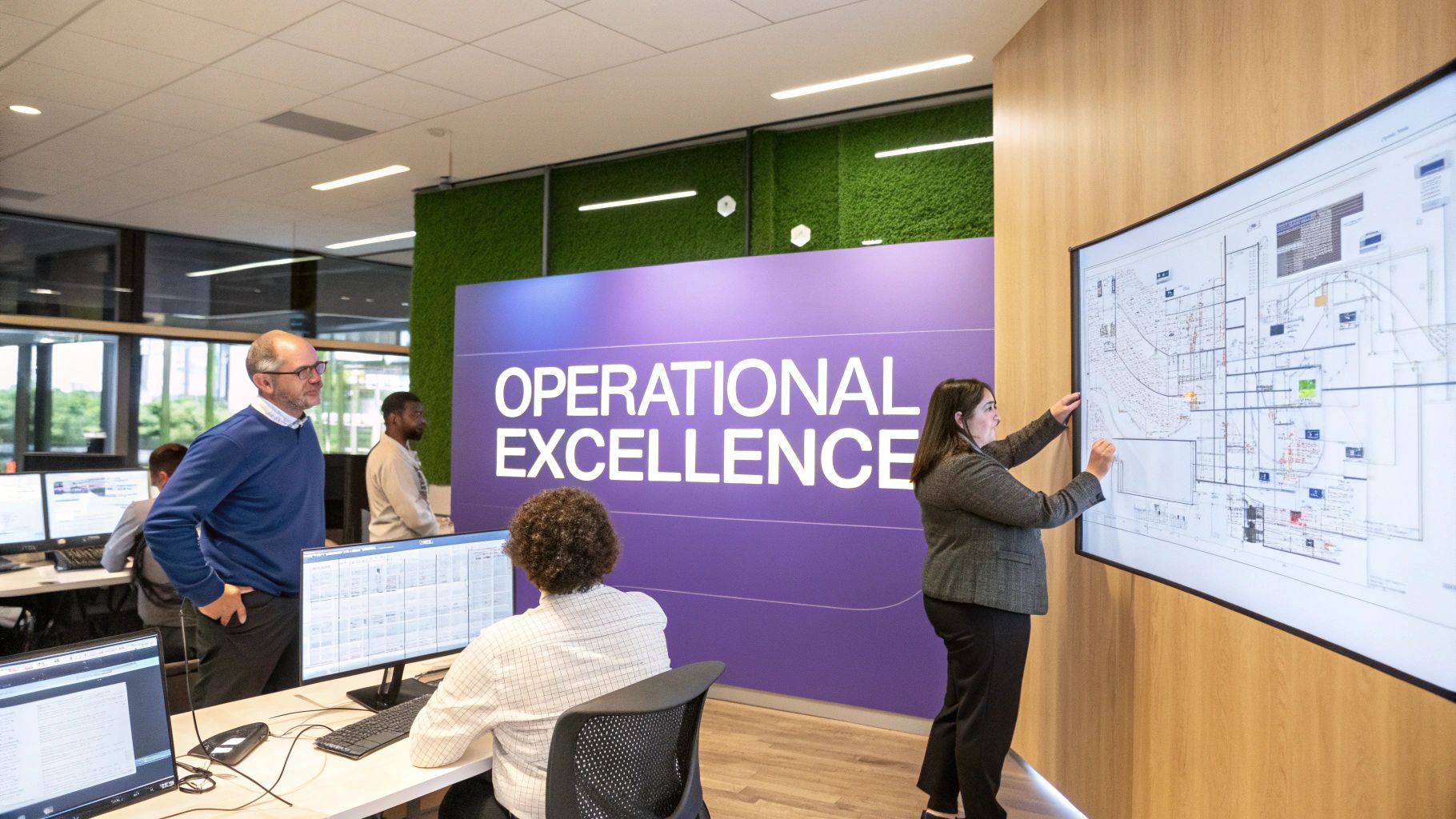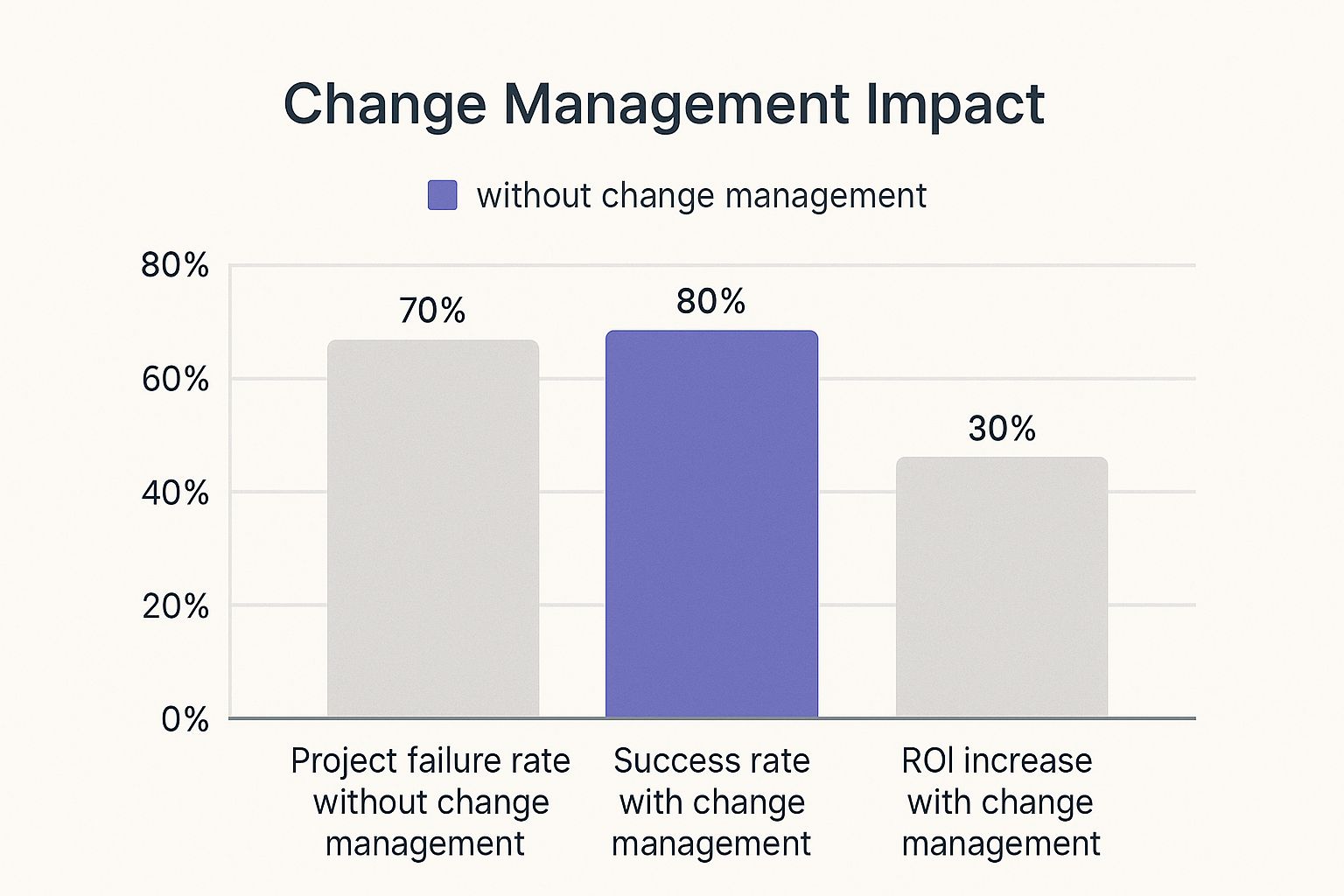Reducing operational costs often brings to mind painful, short-term cuts that harm morale and capability. But what if the goal was not just to spend less, but to work smarter? For leaders in growing organisations, the real opportunity lies not in blunt budget-trimming, but in addressing the deep-rooted inefficiencies that quietly drain resources. It is about tackling the operational fog. The tangled processes, misaligned teams, and creaking technology that make work harder and more expensive than it needs to be.
We believe true transformation starts with people, not platforms. By clarifying how your teams, processes, and technology interact, you can unlock significant savings, free up valuable time, and build a more resilient, capable organisation. This guide moves beyond generic advice to explore ten proven, actionable methods for reducing operational costs in a way that strengthens your business for the long term. From Lean Six Sigma and supply chain optimisation to strategic technology consolidation, each point provides a clear path to reclaiming resources and embedding lasting efficiency. We will focus on practical implementation, helping you build internal capability and achieve a sharper, more sustainable operational model.
1. Lean Six Sigma
Lean Six Sigma is a powerful, data-driven methodology for reducing operational costs by systematically removing waste and reducing process variation. It merges Lean's focus on eliminating non-value-adding activities with Six Sigma's statistical approach to quality improvement. The core idea is simple. Streamline how work gets done to improve quality, speed, and cost-effectiveness simultaneously.
This method forces an organisation to define what its customers truly value. It then ruthlessly eliminates any step in the process that does not contribute to that value. For organisations looking to rigorously eliminate waste and optimise workflows, a structured approach is essential. For a deeper dive, the 5 Steps to Implement Lean Processes offers a detailed guide to identifying and addressing these inefficiencies.
This visual summary highlights the core components of the methodology.

The power of Lean Six Sigma lies in its structured, five-phase DMAIC framework and its clear definition of waste, enabling teams to target improvements that deliver measurable financial returns. To get started, begin with high-impact, low-complexity projects. This builds momentum and demonstrates value quickly, securing buy-in for broader implementation. Proper training for key team members in these principles is non-negotiable for success.
2. Automation and Digitisation
Automation and digitisation is the strategi use of technology to replace manual, repetitive tasks, thereby reducing operational costs and enhancing process accuracy. It involves implementing solutions like robotic process automation (RPA), AI, and digital workflows to handle high-volume activities. The goal is to free up your people for more strategic, value-adding work, while technology handles the rule-based, predictable tasks with greater speed and precision.
This approach requires organisations to identify processes ripe for transformation, particularly those bogged down by paperwork, manual data entry, or repetitive checks. By digitising these workflows, companies not only cut labour costs but also gain significant improvements in speed and data quality. For instance, in finance departments, manual invoice processing is a prime candidate for automation. For a deeper dive into financial efficiency, explore how robust accounting process automation can streamline your operations.
This visual summary highlights the core components of the methodology.

The power of automation lies in its scalability and its capacity to deliver a clear return on investment. As seen with Amazon's warehouse robotics, which cut operational costs by 20%, the impact can be transformative. To begin, start with small, non-critical pilot programmes to demonstrate value and build internal support. A thorough ROI analysis is crucial before committing to large-scale investment, ensuring the technology aligns with strategic business goals and delivers measurable financial benefits. Effective change management and employee training are vital to ensure the new systems are adopted successfully.
3. Outsourcing and Offshoring
Outsourcing and offshoring are strategic methods for reducing operational costs by delegating specific business functions to external third-party providers. Outsourcing involves transferring processes to a provider domestically, while offshoring means moving them to another country to capitalise on lower labour costs. This allows an organisation to leverage specialised expertise and economies of scale, freeing up internal resources to concentrate on core, value-generating activities.
This approach shifts non-critical or highly specialised tasks, like IT infrastructure management or customer service, to partners who can perform them more efficiently. For instance, giants like IBM and Procter & Gamble have realised significant savings by strategically outsourcing IT services. Similarly, many organisations offshore customer support or back-office functions to reduce payroll expenses while maintaining service levels. The key is to move from a cost-cutting mindset to a strategic partnership model.
The power of this strategy lies in its ability to convert fixed overheads into variable costs and access a global talent pool. However, success depends entirely on rigorous partner selection and governance. To get started, identify non-core, repeatable processes that are not a source of competitive advantage. Begin with a smaller, low-risk project to test the relationship and build trust before committing to larger, more critical functions. Clear service level agreements (SLAs), robust data security protocols, and consistent communication are non-negotiable for a successful partnership.
4. Energy Efficiency and Sustainability
Energy efficiency offers a direct and powerful route to reducing operational costs by optimising how your business consumes resources. It involves a strategic focus on cutting energy use, from upgrading equipment to embedding sustainable practices into your culture. This not only lowers utility bills but also minimises environmental impact, enhancing brand reputation and resilience.
This approach forces an organisation to scrutinise its energy footprint, identifying waste in heating, lighting, and machinery. For leaders wanting to make a tangible financial and environmental difference, a structured plan is vital. Initiating a comprehensive commercial energy audit is an effective first step to identify areas for improvement and dramatically cut your business's energy expenditures, as detailed in this Commercial Energy Audit Guide. You can also learn more about how small tech changes can make a big impact.
This visual summary highlights the core components of an effective energy strategy.

The strength of this strategy lies in its tangible, measurable returns. Giants like IKEA and Google have demonstrated that sustainability is not just an ethical choice but a sound financial one, saving billions collectively. To start, prioritise quick wins like switching to LED lighting or installing smart thermostats to build momentum. Leveraging government incentives and engaging employees in these initiatives are crucial for long-term success and securing buy-in across the organisation.
5. Supply Chain Optimisation
Supply chain optimisation is a strategic approach to reducing operational costs by improving the efficiency, visibility, and coordination of the entire supply chain network. It involves refining everything from supplier relationships and inventory management to logistics and distribution, aiming to minimise expenses while maintaining or even improving service levels. Amazon, for example, achieves an estimated 15-20% in annual cost savings through continuous supply chain innovation.
This method requires a holistic view, treating the supply chain not as a series of separate steps but as one integrated system. By aligning people, processes, and technology across this network, organisations can unlock significant savings and build resilience. Properly managing this complex system is critical, which includes understanding how to handle potential disruptions. For those looking to strengthen their operations, a guide to managing risk in the supply chain offers crucial insights.
The power of supply chain optimisation comes from its focus on data-driven decision-making and strategic partnerships. To get started, implement visibility tools for real-time tracking of goods and materials. Use data analytics for more accurate demand forecasting and begin a regular review of supplier contracts to identify savings. Developing strong, collaborative relationships with key suppliers is essential for long-term success and shared value.
6. Workforce Optimisation
Workforce optimisation is a strategic approach to reducing operational costs by aligning your people with business objectives. It moves beyond simple headcount reduction to focus on maximising productivity, developing skills, and improving engagement. The core idea is to have the right people with the right skills in the right roles at the right time, creating a more agile and cost-effective organisation.
This method involves a deep analysis of your current workforce capabilities against future business needs. It is about making data-driven decisions on everything from staffing levels and scheduling to training and performance management. For instance, Southwest Airlines’ renowned cross-training programme allows ground crew to perform multiple roles, enabling 30% faster aircraft turnaround times and significantly improving asset utilisation. Similarly, Cisco's adoption of flexible work arrangements reduced its facility costs by 20% while boosting productivity.
The power of workforce optimisation lies in its holistic view, treating employees as a crucial asset to be nurtured rather than just a cost to be cut. By investing in analytics and employee development, you build a resilient, high-performing team that can adapt to changing market demands. To begin, use workforce analytics to identify skill gaps and overstaffing. Implementing clear performance metrics and regular feedback will ensure everyone is aligned and motivated, driving both efficiency and morale.
7. Technology Infrastructure Consolidation
Technology infrastructure consolidation is a strategic approach to reducing operational costs by standardising, simplifying, and optimising your entire technology estate. It involves merging disparate servers, applications, data centres, and software licences into a more unified and efficient ecosystem. The core idea is to eliminate redundancy, leverage economies of scale, and improve overall system management.
This method forces an organisation to audit its existing IT footprint and challenge the necessity of every component. By moving from a fragmented collection of systems to a cohesive whole, often through virtualisation or cloud migration, businesses can drastically cut expenses related to hardware, energy, and maintenance. For instance, IBM famously consolidated 155 data centres down to just five, generating billions in savings. Similarly, Netflix’s move to the cloud slashed its infrastructure costs by half while boosting its scalability.
The power of consolidation lies in its ability to transform IT from a cost centre into a strategic enabler. It frees up capital and human resources that can be reinvested into innovation and growth. To begin, conduct a thorough audit of all your IT assets to identify clear opportunities for consolidation. A phased migration plan is crucial to minimise operational disruption and ensure a smooth transition for your teams. Finally, regularly review resource utilisation to ensure the consolidated environment remains optimised for performance and cost.
8. Process Reengineering
Process reengineering is a fundamental rethinking and radical redesign of business processes to achieve dramatic improvements in key performance measures. Unlike incremental adjustments, this approach involves completely reimagining how work gets done, making it a powerful strategy for reducing operational costs. It challenges deep-seated assumptions to eliminate inefficiencies at their root.
The goal is to move away from outdated, fragmented tasks and build streamlined, end-to-end workflows. This requires organisations to ask "why do we do it this way?" rather than just "how can we do this faster?". For example, by reengineering its accounts payable process, Ford reduced its departmental headcount by 75 percent, not by automating the old system but by creating a new, simpler one. For a deeper understanding of this transformative approach, you can explore a detailed explanation of what process reengineering is on Yopla.co.uk.
The power of process reengineering lies in its ambition to deliver breakthrough gains, not just marginal improvements. It is best suited for core processes that are broken, cross-functional, and have a high impact on customer value or operational costs. To get started, identify a high-impact process and map it from start to finish, involving employees from all related departments. This collaborative mapping uncovers hidden complexities and builds the necessary buy-in for a radical redesign. Setting clear metrics for success before you begin is essential for measuring impact.
9. Shared Services Implementation
Shared services is a strategic model for reducing operational costs by centralising common business functions like HR, finance, and IT into a single, semi-autonomous unit. This approach creates economies of scale by eliminating redundant roles and standardising processes across multiple business units, improving efficiency while maintaining or even enhancing service quality. The core idea is to treat internal support functions like a business, focused on delivering high-quality, cost-effective services to its internal clients.
This model forces an organisation to stop duplicating transactional work in every department and location. Instead, a dedicated shared service centre (SSC) handles these high-volume tasks, freeing business units to focus on their core, value-generating activities. For example, General Electric famously saved over £1.2 billion in five years through its shared services centres, while P&G's Global Business Services reduced annual costs by over £700 million.
The power of shared services lies in its ability to drive standardisation and continuous improvement at scale. By consolidating functions, organisations gain visibility into process performance, allowing them to identify bottlenecks and optimise workflows more effectively. To begin, start with highly transactional, rule-based processes like accounts payable or payroll. Establishing clear service level agreements (SLAs) and investing in robust change management are critical for a smooth transition and long-term success.
10. Strategic Cost Management
Strategic cost management is a comprehensive, forward-looking approach to reducing operational costs by aligning cost structures with long-term business objectives. It shifts the focus from arbitrary, short-term budget cuts to creating sustainable value by analysing cost drivers, value chains, and competitive positioning. This method integrates cost information into the strategic decision-making process, ensuring every cost-saving initiative supports growth and competitive advantage.
This approach forces an organisation to look beyond the purchase price and consider the total cost of ownership across the entire lifecycle. It employs powerful techniques like activity-based costing to reveal the true cost of products and services, and target costing to design profitability into new offerings from the start. For leaders aiming to make smarter, more strategic financial decisions, this framework is invaluable. It answers not just "where can we cut?" but "where should we invest to become more efficient and competitive?".
The power of strategic cost management lies in its holistic view, connecting operational activities directly to financial performance and market strategy. It transforms cost management from a reactive, defensive function into a proactive, strategic tool for value creation. To begin, use cross-functional teams to analyse key value chains, identifying activities that drive the most cost and the least customer value. Focusing on total cost of ownership, rather than just initial price, will uncover significant, often hidden, opportunities for savings and efficiency gains.
Top 10 Cost Reduction Strategies Comparison
Ready to Build a More Capable Organisation?
We have explored a comprehensive toolkit for reducing operational costs, moving far beyond simple budget cuts. From the structured rigour of Lean Six Sigma and process reengineering to the strategic leverage of automation, outsourcing, and supply chain optimisation, it is clear that sustainable efficiency is a multi-faceted discipline. The common thread connecting these powerful methods is not merely cost reduction, but value creation. Each approach is ultimately about building a more resilient, agile, and capable organisation.
However, knowing the what is very different from mastering the how. The true challenge lies in orchestrating these initiatives without disrupting momentum or losing sight of the bigger picture. The most common pitfall we see is leaders treating these strategies as isolated projects. A technology upgrade is initiated without considering process impacts, or a cost-cutting measure is implemented that inadvertently demoralises the very people needed to drive future growth. This siloed approach creates friction, wastes resources, and rarely delivers lasting results.
Moving from insight to impact.
The journey to operational excellence is not a solo endeavour. It requires a clear, shared understanding across your people, processes, and technology. This is where a strategic partner can provide critical perspective. Key takeaways from our exploration include:
- Holistic vision is non-negotiable. True transformation starts by seeing the entire system. Before implementing any single solution, you must understand how it connects to every other part of your operation.
- People drive the process. Technology and methodologies are merely enablers. Lasting change is only possible when your teams are aligned, engaged, and equipped with the skills to own new ways of working.
- Continuous improvement is the goal. Reducing operational costs is not a one-time fix. It’s a cultural shift towards constant refinement, driven by data and a collective commitment to eliminating inefficiency.
Your next step towards sustainable growth.
At Yopla, we specialise in clearing the operational fog. We act as a copilot, working alongside your team to map your current state and design a clear, actionable roadmap for the future. We don’t deliver complex slide decks and walk away. Instead, we use our transparent Plans Portal to build collective intelligence and embed capability directly within your organisation.
This approach ensures you achieve digital sovereignty, leaving your teams stronger, more aligned, and fully in control of their processes and platforms. If you are ready to move beyond fragmented efforts and build a truly efficient, modern, and capable organisation, let's talk.











